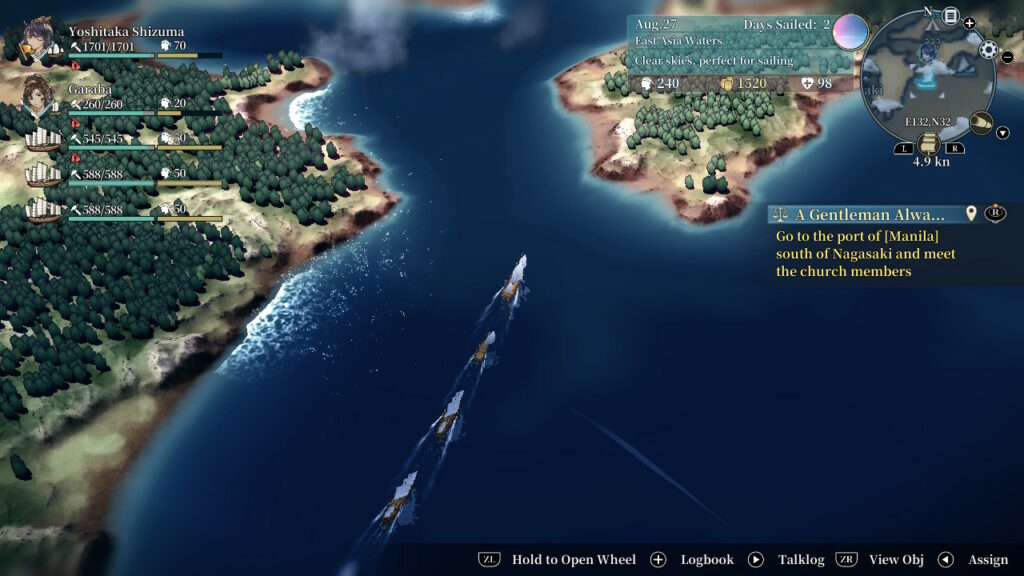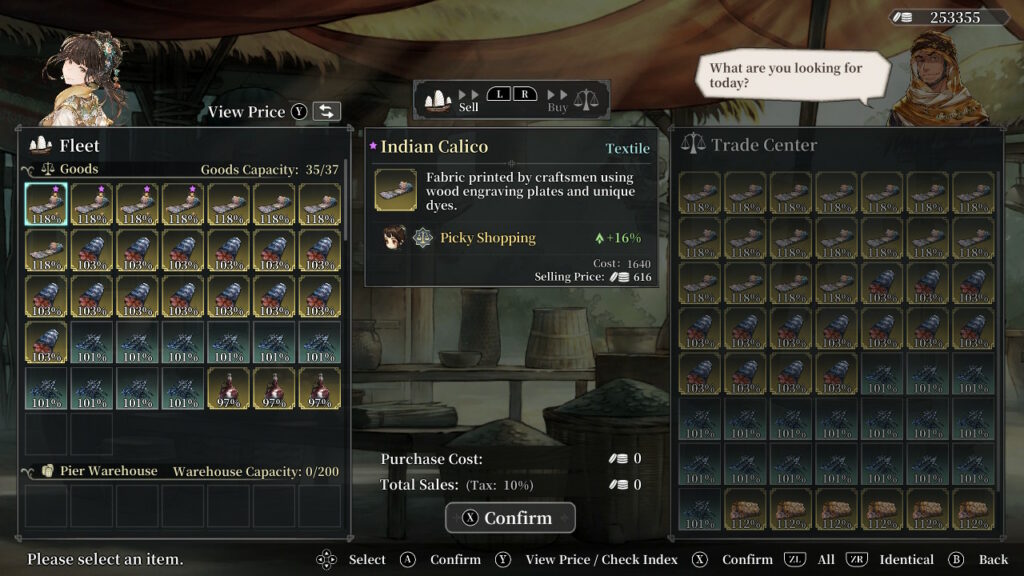Review: Sailing Era (Switch)
Sailing Era is a weird mix. Its portraits are bright, expressive, and fun, but its 3d models feel somewhat lifeless and drab. A lot of the game feels the same way. For example, It’s really satisfying to make a good trade and shore up your cash-on-hand… but beyond a certain point, trading becomes meaningless because it is too profitable. This makes the whole system feel a little… unmoored. Another good example is explorations – they’re a great source of experience for your crew, and often yield useful treasure or discoveries you can turn in for port contribution points. They’re actually even a little bit fun in how they throw different challenges as you every so often. But the challenges don’t grow with your crew or even by “danger level” so you’re likely to outstrip them after about 5 hours of play – and without the need for growth, there is little need for the experience.
In the end the experience feels a bit like an idle game with extra steps. You’re leveling your crew to make leveling your crew easier, trading to get money to upgrade your trading ships to trade faster, fighting other ships for loot to build better ships to fight with, and so on.

This isn’t to say that it’s a bad game – actually a lot of games are like this, and I actually found it simultaneously addictive and relaxing. In Sailing Era it feels a little more blatant though. Like its inspiration, Uncharted Waters, Sailing Era is an easy game. The first couple hours may be tricky as the main quest throws some hard battles at you, or the trading situation may feel a little tenuous before you’ve built a fleet. Once you’re past a certain point – say, you have three ships in your fleet and are relatively comfortable with crew wages – you’re trading so many goods at a time, and the relative pricing for trades so generous, that you can easily turn a major profit.
If you’ve never played Uncharted Waters, this might best be described as a role-playing simulation game. It’s a sandbox scenario, set in the real world, where you control a fleet and can trade, battle other fleets (piracy or targeting pirates), explore to find discoveries, and otherwise generally aid the imperialist cause. All of your characters have levels and skills, you can order and customize ships, take on quests to hunt pirates or ship goods, and sweet-talk barmaids (dialog is the same for Yun Mu, unfortunately). There are four main characters to choose from – similar to a SaGa game in that each has its own storyline, and some sidequests are slightly different, but otherwise the world is the same. Refreshingly only one main character is from Europe.
Recruiting characters is a major gameplay motivator, as each character has rule-bending abilities (some more powerful than others). Each main character has a fairly powerful ability, but can only be recruited by other main characters once their story has been completed. Others make trading slightly better in an area, slightly improve a fleet stat, or offer other minor bonuses. Characters can also be assigned roles on the flagship, which gives them a chance to give small passive bonuses to the whole fleet – similar to Infinite Space, except occasionally these bonuses are noticeable. Unfortunately, finding these characters can be a major chore, and they are much more dense in certain areas than others (for example, I can only think of two characters available in Africa and none in South America). I’d suggest using an FAQ or character guide to at least get a feel for where the easiest ones are. There aren’t any hints readily available in-game, which would have been a much better use of the “random dialog” bar/cafe characters than their actual use.
Likewise, building or buying ships is typically a major upgrade. Like the original Uncharted Waters, there are many ships that aren’t particularly useful beyond roleplay, but unlike it there is more detailed customization. Ships can be re-armored, have their sails reconfigured, and storage space converted to flagship appointee rooms. Some options (like crew quarters) seem missing, but it is satisfying to reconfigure a ship just the way you want it. Custom-ordering a ship is hard to do, though, as it requires specific materials that can be hard to come by. Getting the largest ship types is difficult, since at scenario start all cities start at a low tech level and gradually increase. Galleons or Frigates aren’t available until later on – or until you choose to invest in the port via the Guild system. While this provides an outlet for all the excess money you’re likely to have from trading, it’s a system that’s both bland and opaque – your money fills a pool that gradually gets funneled into one of three city stats, and it’s not always clear which stat is needed for what you’re looking for (whether it’s ships available for sale, trade goods, consumable items, equipment, or ship materials).
Other systems, like ship-to-ship negotation, seem half-baked; there’s some kind of reputation stat that affects what goods are on offer from a specific fleet, and no indication whether there are hidden goods due to low reputation. Likewise, pirate attacks seem random; sometimes “dangerous waters” spawn pirate attacks that appear out of nowhere (frequently at port, on departure), while at other times a wandering fleet that happens to be pirates may attack. While this is somewhat carried over from Sailing Era’s inspiration, it is a little frustrating that there is no negotiation option available once combat has started.
Ship-to-ship combat is a real-time, action affair, but it’s relatively barebones. Cannons can be fired manually on one side at a time, or automatically out the front or back if your ship has guns there. Boarding occurs automatically once ships come close enough. Any non-flagships in your fleet join the fight While there’s a morale system, it’s hard to know how effective your crew will be in combat, since you don’t know how many crew an enemy has or what their morale is. This is a little frustrating, since boarding also gives the best loot from combat.

Land Exploration is the final system I haven’t really covered – it’s kind of a survival mode where you’re trying to find specific areas on the map and pass skill checks on your designated party of four. There are no real penalties for running out of stamina during an exploration (you may miss out on a token amount of EXP), so lack of supplies only really induces a bit of anxiety. Preparing for the trip involves stocking up on various tools – axes, lanterns, grapples, etc – and random events may consume them for rewards, or reward them based on stat/skill checks. It’s relatively bland, but does make for a good change of pace.
Setting-wise, Sailing Era does gloss over much of the exploitation / imperialism of the time – while there are some sidequests involving stopping slave-trading, that’s about as deep as it goes and the recruitable crew are mostly focused in Europe and East Asia. It’s also a little inconsistent about what time this exploration occurs, to the point of not actually stating any years; it’s certainly after Portuguese exploration of India, but there are also Dutch traders near the Spice islands, but at the same time China is referenced explicitly as “Ming”, which would otherwise date it to around 1600ish. Pirates are active in the Caribbean, and one is modeled after (and named) Blackbeard, who was active around 1700. So yes, it’s a mix. There is DLC available for PC that appears to focus on the Hansa, so maybe there will be further DLC that actually incentivizes exploring, say, North America or Australia – but in the current game (as I played it on the Switch) there is little reason to go those places. The translation is a little iffy in places, particularly frustrating given some stories (like Abdullah’s) involve a lot of deception and it feels like some subtext is missing. It’s serviceable for most of the game, though.
Overall, I did really enjoy Sailing Era – for all that I rag on it above, it’s a relaxing and fun sandbox, and was a great diversion from story-heavy RPGs and strategy games. Hopefully any sequels and further DLC add to its depth.